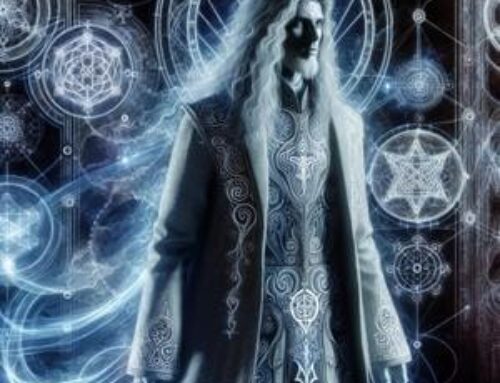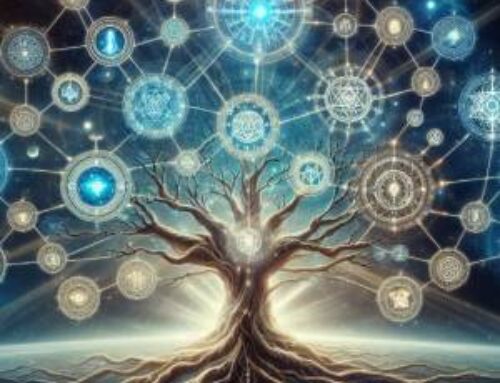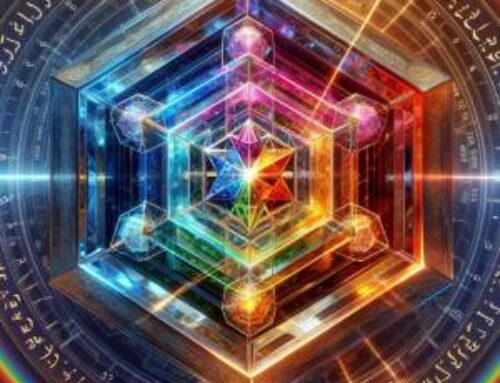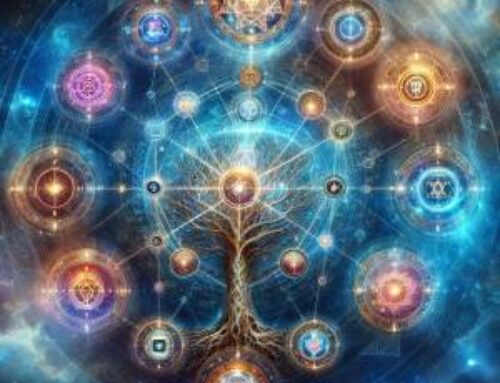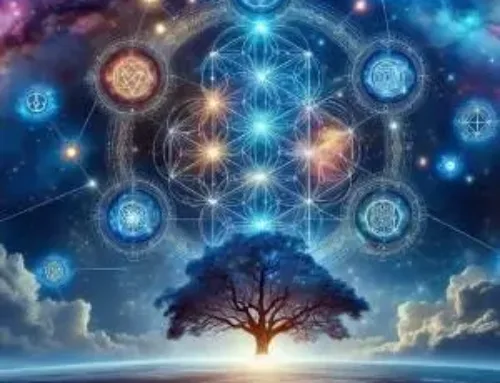Contents
Introduction to Kabbalah and God
In an era where the spiritual and the material realms converge, Kabbalah and the Divine stand as monumental beacons of mystical exploration, providing portals to decipher the universe’s deepest enigmas. This discourse ventures through the elaborate weavings of Hermetic and Kabbalistic doctrines, shedding light on the complex interplay between the cosmos and the divine quintessence. According to this doctrine, the absolute is Being and therein is the Word which expresses the reason of Being and of life (1).
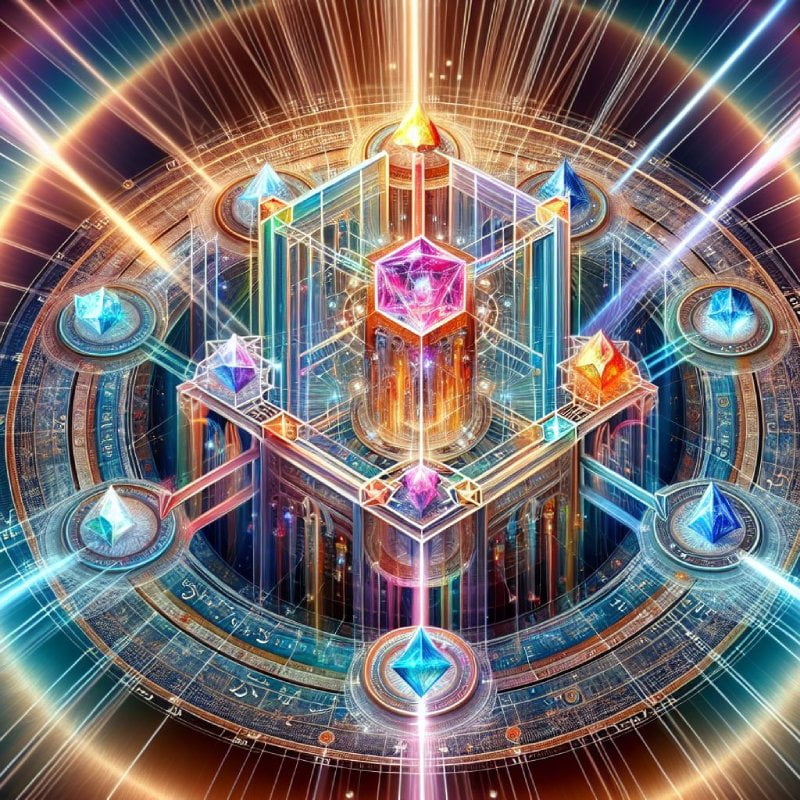
Kabbalah, an esoteric interpretation of the Bible, offers a schema to fathom the essence of God and the cosmos. Through its elaborate configuration of Sephiroth—divine outpourings—Kabbalah depicts a universe woven with spiritual dynamics. Hermeticism, grounded in the lore of Hermes Trismegistus, echoes Kabbalistic themes, championing a comprehension of the vast and the minute, and the human role within this celestial schema.
The Sephiroth: Ten emanations represent the process of creation and the nature of the divine, forming a tree of life structure (2).
This investigation transcends the scholarly to touch the profoundly personal, engaging notions that recalibrate our views and propel spiritual and cognitive expansion. By weaving Kabbalistic revelations with Hermetic insights, our quest is not merely for knowledge but for deeper understanding—insights into ‘Kabbalah and God’, their expressions in our lives, and their transformative influence on our perception of existence and purpose.
As we advance, we will delve into the essential tenets of Kabbalah, probe the synergies with Hermetic thought, and reveal the tangible implementations of these age-old wisdoms. Navigating through these mystical terrains promises not only enlightenment but also the impetus for personal and communal growth.
The primal tradition of the one and only revelation has been preserved under the name of Kabbalah by the priesthood of Israel (3).
The Fundamentals of Kabbalah and the Nature of God
Understanding the Sephiroth: Divine Emanations of God
The study of Kabbalah and God reveals a complex system of divine emanations that guide spiritual and worldly order. Kabbalah introduces the concept of the Sephiroth, which are ten divine emanations or attributes through which the Infinite, known as Ain Soph, manifests His will and interacts with the universe. Each Sephirah is an essential aspect of God’s character; for instance, Chesed represents mercy while Geburah signifies justice. These are not merely abstract concepts but are considered actual channels through which divine energy flows into the world, affecting creation and influencing human affairs.
The Sephiroth are organized in three columns or pillars on the Tree of Life, which is a diagrammatic representation used in Kabbalistic study. The right column, known as the Pillar of Mercy, includes Sephiroth characterized by expansion and benevolence. The left column, or Pillar of Severity, comprises Sephiroth associated with discipline and withdrawal. The middle column is the Pillar of Equilibrium, balancing these opposing forces, exemplifying the Sephiroth such as Tiphareth (beauty) which harmonizes mercy and judgment.
The Tree of Life is formed by the Sephiroth constituting three distinct triads, each representing different aspects of the world: the intellectual world, the moral world, and the material world. These triads are structured with three masculine Sephiroth on the right, three feminine on the left, and four uniting Sephiroth in the center (4).
Ain Soph: The Infinite Nature of God
At the heart of Kabbalah is the idea of Ain Soph, which translates as “without end” or the Infinite. This concept posits that God’s true essence is boundless and beyond human comprehension. Ain Soph is not depicted as an old man in the sky but rather as a fundamental and underlying force that transcends existence yet is immanently present in all things.
The Ain Soph’s unknowable nature is a central theme in Kabbalistic thought, implying that while we can know God’s attributes and actions through the Sephiroth, His essential nature remains hidden. To meditate on Ain Soph is to contemplate infinity and to recognize our own finite understanding.
The Tree of Life: A Pathway to Divine Unity
The Tree of Life is not only a framework for understanding the relationship between the divine and the mundane but also a map for spiritual ascent. It is through navigating this Tree that Kabbalists engage in the process of Tikkun Olam — repairing the world and elevating the sparks of holiness concealed within it.
Each Sephirah on the Tree of Life offers a different facet of divine expression and an opportunity for personal and spiritual development. The journey begins at Malkuth, the kingdom, which represents the physical world as we experience it, and ascends through levels like Yesod, the foundation, which connects to our emotions, up to Kether, the crown, representing the closest attainable proximity to divine consciousness.
Intersection of Hermetic Philosophy and Kabbalistic Insights
As Above, So Below: The Hermetic Connection
The Hermetic adage “As above, so below” quintessentially captures the essence of the dialogue between the macrocosm (the universe) and the microcosm (the individual). This principle, a cornerstone of Hermeticism, reflects the Kabbalistic belief that human endeavors mirror broader cosmic movements and that the universe’s structure reverberates within human life. Hermetic texts delve into the dynamics of this correspondence, which spans the philosophical to the practical, impacting practices in alchemy, astrology, and spiritual rituals.
Human Soul and the Divine: The human soul is seen as a microcosm of the divine structure, with parts corresponding to the Sephiroth (5).
Hermetic Texts and Kabbalistic Parallels
Hermeticism, credited to the wisdom of Hermes Trismegistus, and Kabbalah, originating from distinct cultural soils, exhibit significant mystical overlap. Both traditions underscore the necessity of esoteric wisdom to decrypt the divine design of the cosmos. For example, the Kybalion, a modern interpretation of Hermetic principles, aligns closely with the Zohar, a seminal text in Kabbalistic study, in its discussion of divine outflows and the soul’s transformative odyssey.
God is the all-working; He is the effect of Nature, working for the perfecting of the Universe.” (Book II: To Asclepius) – Suggesting the alchemical work as part of the divine plan for perfection (6).
Both Hermetic and Kabbalistic teachings explore the concept of primal matter or Prima Materia, the fundamental essence from which all existence springs. In Kabbalah, this concept parallels the notion of the Ain Soph emitting through the Sephiroth to foster and uphold the universe. Hermeticism similarly posits that a unified source material, shaped by divine intellect, forms the foundation of both the physical and spiritual worlds.
Transformative Practices: Pathways to Spiritual Enlightenment
A profound confluence between Hermeticism and Kabbalah is their mutual advocacy for transformation through direct engagement with the divine. Both philosophies promote meditation, invocation, and ritual as avenues to spiritual enlightenment. These activities strive to harmonize the practitioner’s soul with divine universal currents, deepening their comprehension of and connection to the divine.
Practitioners from both traditions undertake these rituals not only for personal enlightenment but also as a contribution to the cosmic balance, facilitating the restoration and sustenance of universal harmony. The journey entails a purifying climb through various spiritual levels, reminiscent of the ascension through the Kabbalistic Sephiroth or the spiritual alchemy depicted in Hermetic writings.
Philosophical and Ethical Implications
Both frameworks also probe the ethical dimensions of life within a cosmically integrated reality. They assert that grasping the divine architecture is intrinsically tied to virtuous conduct and that spiritual insights should translate into ethical deeds. This moral obligation is evident in the Kabbalistic commitment to Tikkun Olam (mending the world) and Hermetic imperatives to live in accord with cosmic ordinances. Hermetic philosophy and Kabbalah provide complementary perspectives on the cosmos, each enriching our understanding of Kabbalah and God.
Evolutionary Spirituality in Kabbalah
The Cosmic Plan and Human Evolution
Kabbalistic teachings propose a grand cosmic narrative in which human beings play a central role in the divine scheme. The concept of Tikkun Olam, or repairing the world, is a pivotal aspect of this narrative, where humans are seen not merely as passive recipients of divine grace but as active participants in the spiritual evolution of the universe. This perspective is intrinsically linked to the belief that every human action contributes to the cosmic balance, enhancing or hindering the flow of spiritual energy through the Sephiroth.
Soul’s Journey Through Gilgulim (Reincarnations)
Evolutionary spirituality in Kabbalah posits that our souls’ journeys are intrinsically linked to divine processes, underscoring the profound connection between Kabbalah and God. A distinctive element of Kabbalistic spirituality is the belief in Gilgulim, or the reincarnation of souls, which posits that souls return to the earthly plane multiple times to achieve spiritual perfection and fulfill their part in the divine plan. This process is integral to the evolutionary spirituality of Kabbalah, as it underscores the developmental nature of the soul’s journey towards enlightenment. Each incarnation provides opportunities for the soul to rectify past misdeeds, acquire new insights, and advance closer to complete union with the divine essence.
Divine Sparks and Human Responsibility
According to Kabbalah, the physical world contains hidden Divine Sparks that were scattered at the moment of creation. Human beings, through their righteous actions and spiritual practices, are tasked with gathering these sparks to restore them to their original source in the divine realm. This mission not only promotes the idea of a proactive spiritual life but also imbues everyday human actions with profound cosmic significance. The act of elevating these sparks through charity, prayer, and moral living transforms mundane activities into vital components of the spiritual reconstruction of the universe.
The Role of Mystical Practices and Asceticism
Kabbalists employ various mystical practices aimed at personal and cosmic transformation. Meditation on the Sephiroth, intricate rituals designed to mirror celestial patterns, and ascetic practices to purify the body and mind are all components of the Kabbalistic path. These practices are designed to help the practitioner align more closely with divine will, enhancing their ability to interact with and elevate the divine sparks.
Ethical Living as a Spiritual Imperative
In Kabbalah, ethical living is not just a social requirement but a spiritual imperative. The moral laws and commandments are seen as direct pathways to influence the cosmic order positively. By living ethically, Kabbalists believe that individuals can affect the spiritual realms, bringing divine light into the world and hastening the arrival of a perfected age. This intertwining of ethical action and spiritual progress defines the Kabbalistic approach to evolutionary spirituality, where the ultimate goal is the harmonization of all existence under the rule of divine goodness.
Conclusion
In this exploration of “Kabbalah and God”, we’ve traversed from the intricate mappings of the Sephiroth to the philosophical underpinnings shared with Hermetic traditions, and further into the evolutionary spiritual duties outlined in Kabbalah. We’ve seen how these mystical teachings not only aim to explain the cosmos but also assign humanity a proactive role in the divine scheme through the process of Tikkun Olam—repairing the world.
Kabbalistic teachings illuminate a path where human actions are deeply consequential, woven into the very fabric of the cosmic plan. Each individual’s spiritual journey through the practices of Kabbalah—meditation on the divine emanations, ethical living, and the pursuit of wisdom—serves both personal growth and the universal goal of cosmic harmony (7). Embracing the teachings of Kabbalah and God not only enhances personal enlightenment but also contributes to the cosmic symphony of spiritual evolution.
Encouraging Further Engagement
For those drawn to these ancient wisdoms, the journey is as profound as it is transformative. Engaging with the teachings of Kabbalah offers a unique lens through which to view one’s life and the universe. For deeper exploration and practical application of these spiritual teachings, the Hermetic Academy provides courses and resources that guide individuals on their path to spiritual enlightenment. Joining the Academy can be a significant next step for anyone seeking to integrate these esoteric teachings into daily life, fostering a personal connection with the divine and contributing to the universal process of healing and restoration.
FAQ – Kabbalah and God
1. What is Kabbalah and how is it connected to the concept of God?
A: Kabbalah is a mystical and esoteric interpretation of spiritual teachings, deeply embedded within the Western tradition. It offers a complex framework for understanding the nature of God, the universe, and the soul’s connection to both. At the heart of Kabbalah is the concept of the Sephiroth—ten divine emanations that transmit God’s essence into the world, providing a schematic for both cosmic and individual evolution. Kabbalah introduces God as Ain Soph, the infinite and unknowable, whose presence suffuses all of creation. This article delves deep into the mystical relationship between Kabbalah and God, exploring the divine architecture that shapes our universe.
2. How do Hermetic principles relate to Kabbalistic teachings?
A: Hermeticism and Kabbalah converge on numerous philosophical grounds, including the maxim “As above, so below,” which delineates the reflective relationship between the cosmos (macrocosm) and the individual (microcosm). Both doctrines apply this principle to depict how terrestrial incidents and astral dynamics are interconnected, utilizing similar mystical modalities such as meditation and ritual to harmonize with these forces, thus promoting personal and cosmic equilibrium.
3. What is the purpose of the Sephiroth in Kabbalah?
A: In Kabbalah, the Sephiroth operate as channels through which the divine essence is manifested and ordered. They symbolize various facets of God’s personality—like wisdom, understanding, strength, beauty, and sovereignty—and regulate the corresponding domains within the universe. By engaging with the Sephiroth, practitioners gain insights into and can influence their spiritual and material surroundings, striving for personal development and global betterment, known as Tikkun Olam.
4. How does one begin their study of Kabbalah and incorporate its teachings?
A: Embarking on the study of Kabbalah involves immersing oneself in a community that provides structured education, such as the Hermetic Academy. This foundational step is vital for grasping and integrating Kabbalistic concepts and practices effectively, facilitating both theoretical knowledge and practical application in spiritual pursuits.
References:
(1) Eliphas, L. (1854). Dogme et Rituel de la Haute Magie. Paris.
(2) Mathers, S. L. M. (1887). The Kabbalah Unveiled. London.
(3) Eliphas, L. (1854). Dogme et Rituel de la Haute Magie. Paris.
(4) Mathers, S. L. M. (1887). The Kabbalah Unveiled. London.
(5) Mathers, S. L. M. (1887). The Kabbalah Unveiled. London.
(6) Ficino, M. (1471). Corpus Hermeticum. Florenz
(7) Rubenstein, E. (2020). The Tree of Life: The Kabbalah of Immortality. Hermetic World, Paphos.

